Abstract
The field of energy is of great interest for development, especially in the transportation industry. This paper investigates a hybrid electric vehicle (HEV) with two-wheel drives powered by a fuel cell, battery, DC generators, and supercapacitors. Each energy source is connected to a specific controllable converter. The authors compared the energy management strategies of the Adaptive Neuro-Fuzzy Inference System (ANFIS) with classical energy management strategies. The proposed ANFIS method reduced hydrogen consumption by 8% compared to the classical approach, and improved efficiency to over 98%. The primary objective of this work is to demonstrate the impact of artificial intelligence in renewable energy management strategies (EMSs), with the aim of improving system performance as much as possible by comparing it with classical methods such as state machine (SM) and PI strategies.
1. Introduction
With the advancement of technology, hybrid electric vehicles (HEVs) have undergone significant development and have become an essential mode of transportation. The domain of HEVs is under immense pressure to produce energy-efficient and non-polluting renewable-energy-based hybrid power systems.
HEVs are recognized as a practical solution for reducing emissions and conserving energy in transportation, especially given the current technical conditions. They can address the issues associated with conventional fuel cars [1,2].
The inclusion of various green resources in automobiles has garnered interest from both businesses and academia to improve electric vehicle (EV) autonomy and conserve renewable resources by ensuring their efficient use while considering resource energy as a function [3,4].
Hybrid electric vehicles (HEVs) powered by fuel cell (FC) sources have become a practical transportation method today, as they are considered one of the green sources due to their low air/fuel consumption without pollution [2,5].
Several technologies enhance the vehicle’s energy, such as vehicle-to-grid technology (V 2 G) [6] and hybrid vehicles that incorporate photovoltaics (PV) [7]; however, despite the modernity of the technologies, there is a lack of an energy management system.
In addition to the fuel cell as a direct energy source, a battery energy storage system (BESS) can maintain energy balance in the HEV system and ensure DC bus voltage stability at a predetermined level [8]. A supercapacitor (SC) is often used as an auxiliary energy storage system in hybrid systems to regulate transient power variations and supplement the BESS to maintain energy balance in the system [1,3,9].
Researchers have improved EMSs by using artificial intelligence techniques such as ANFIS and neural networks (NNs) [1,10,11]. This research aims to minimize hydrogen consumption in fuel cell hybrid electric vehicles through the implementation of intelligent techniques, specifically ANFIS artificial intelligence, in energy management [1,10,12]. The problem statement of this research is centered around reducing hydrogen consumption using intelligent techniques. The main focus of this research is to employ ANFIS artificial intelligence in the energy management of fuel cell hybrid electric vehicles.
2. HEV System Explication
The research focuses on an HEV system that employs an induction motor drive. The energy storage systems are composed of a battery and a supercapacitor. The inverter is responsible for controlling the speed algorithm that powers each motor. The HEV comprises an FC, a battery, an SC, and DC generators that are connected to a special converter. The FC is the primary source, and the DC generators connected to the front wheels directly supply power to the DC bus. The energy management strategies, including ANFIS and other classical techniques, are responsible for managing the energy between the sources. Figure 1 illustrates the HEV system under study.
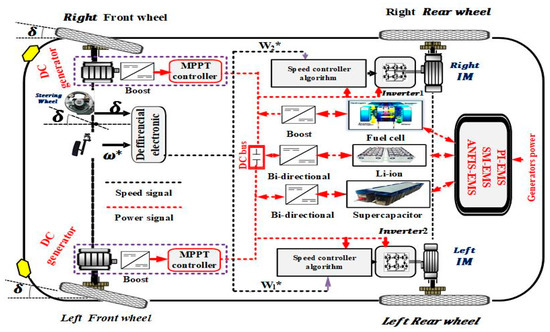
Figure 1.
Hybrid electric vehicle model.
3. Modelization of Hybrid System
3.1. Battery Model
Lithium-ion batteries are currently the most commonly used energy storage system in transportation [9]. The battery model utilized in this study is described by Equations (1) and (2) [13,14].
where SOC, Q, Cbat, t, and Ibat are the battery’s state of charge, quantity of charge, battery capacitor, discharging time, and battery current, respectively.
Equation (2) represents the battery’s capacitor [13].
where Δt, CX, and IX are the accumulator heating, rated capacity, and rated current, respectively.
3.2. Supercapacitor ESS
Besides the battery, the SC is the second ESS working in the fast intervention [15]. The SC’s mathematical model is illustrated in Equation (3) [13].
where Vu, Ru, Vu′, Iu, Qu, C0, and β are, respectively, SC voltage, series resistance, primary cell voltage, SC current, fast charge, capacitance, and constant parameter.
3.3. Fuel Cell
In this study, the FC is considered the primary source and is regarded as a green source that converts chemical energy into electrical energy [16]. The first principle of thermodynamics is applied to analyze the energy of the FC, and Equation (4) is used to model the FC [1,13,16].
The fuel cell voltage is given by Equation (5):
where O2, H2, and H2O are the chemical abbreviations of oxygen, hydrogen, and water, respectively.
3.4. DC Generator
A DC generator is a machine that converts mechanical energy to electrical energy. In this study, the rotor is connected to the EV wheel and rotates due to the EV’s kinetic energy. The DC generator model is represented by Equation (6) [3,17,18]:
where are the output DC voltage, generator resistor, electromotive force generator current, and generator power.
4. Renewable Energy Management Strategy REMS
4.1. PI-EMS
The PI-EMS is a classical EMS that employs proportional and integral operators to minimize the state-of-charge (SOC) error and preserve the SOC. The PI-EMS provides orders to the FC to secure the necessary power to maintain the SOC, as illustrated in Figure 2 [1,13].
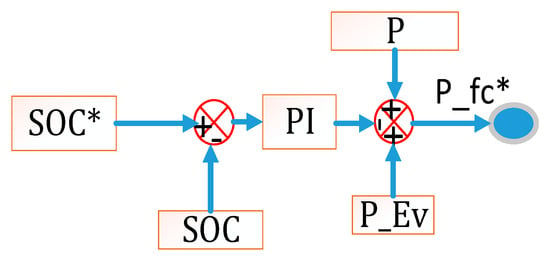
Figure 2.
PI energy management technic.
4.2. SM-EMS
The SM-EMS is one of several classical energy management systems utilized in renewable energies. This technique is based on the pre-knowledge of the designer. Figure 3 depicts the SM-EMS algorithm utilized in this study [1,13].
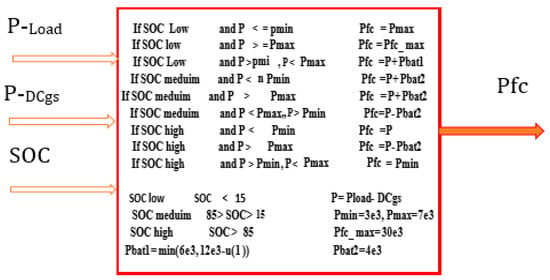
Figure 3.
State machine algorithm.
4.3. ANFIS-EMS
In recent years, EMSs have undergone significant development, especially in the area of artificial intelligence. Among the widely used strategies for transportation control and management is ANFIS. ANFIS operates by utilizing data to generate the membership output/input required for power distribution. However, tuning this strategy to achieve optimal function can be challenging, mainly due to the difficulty in selecting the appropriate data for the system. Nonetheless, the ANFIS controller’s core requires the knowledge and expertise of an expert. The objective function of the ANFIS-EMS design is to conserve battery power while minimizing hydrogen consumption. Figure 4 illustrates how the ANFIS-EMS design’s output depends on the selected database [1,12,19,20].
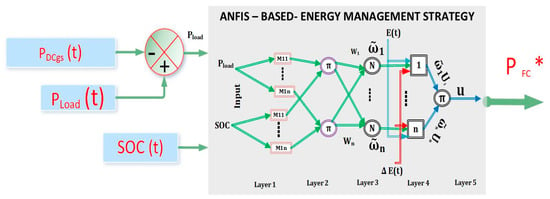
Figure 4.
ANFIS energy management topology.
The explication of the ANFIS controller is detailed in [20] and in refs [3,21].
5. Simulation Results
The simulation time for the system is set at 120 seconds, using the same parameters and initial conditions, and incorporating three EMS strategies, namely, PI, state machine, and ANFIS. The EV’s trajectory is depicted in the table below, which outlines the various paths it follows. Table 1 illustrates the EV speed schedule for each of these paths.

Table 1.
The EV speed schedule.
Figure 5 illustrates the main results of the EV’s motor control. Figure 5a is the EV wheel speed varied with time, where Figure 5b shows the speed errors less than 2 (km/h) in the transitional regime. Figure 5c illustrates the electromagnetic torque of each motor, where the electromagnetic torque gave the ripple of 0.8 Nm as shown in Figure 5d.
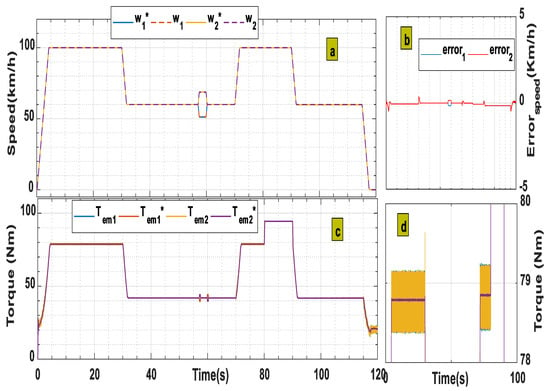
Figure 5.
HEV motor’s responses: (a) wheels speed; (b) speed error control; (c) wheels electromagnetic torque; (d) torque ZOOM.
Figure 6 depicts the comparison results of the three EMS methods: PI, SM, and ANFIS. The responsible power sources for the EV are FC, battery, SC, and DC generators. The FC serves as the primary source, generating the required power for the EV, with the battery, SC, and DC generators serving as secondary sources according to the EMS conditions.
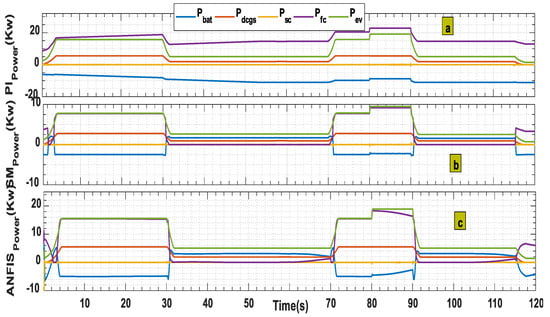
Figure 6.
HEV power using the proposed scenario: (a) using PI-EMS; (b) using SM-EMS; (c) using ANFIS-EMS.
The battery acts as a permanent energy storage unit, securing the EV’s function according to the EMS, while the second energy storage unit offers fast intervention as needed. The DC generators supply energy directly to the DC bus.
The SM-EMS and ANFIS-EMS strategies have nearly identical objective functions, with a slight variation in the power value. In contrast, the PI-EMS strategy adheres to a condition that preserves the reference value of the battery’s state of charge.
Figure 7 illustrates the DC bus voltage stability for the three EMS methods: PI, SM, and ANFIS. All three EMSs adhere to the voltage reference value (400 V) without any visual overtaking and have an acceptable response time, with a ripple of 0.02%. Figure 8 represents each EMS’s hydrogen/air consumption, using three EMSs (PI, SM, and ANFIS EMSs).
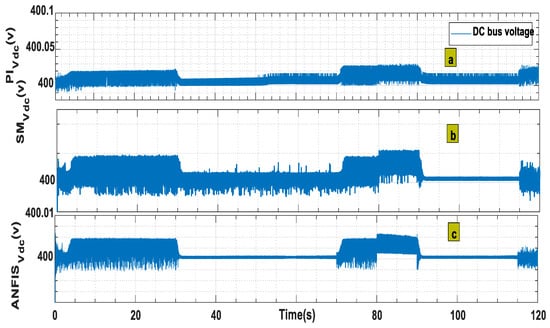
Figure 7.
DC bus voltage of the proposed scenario: (a) PI-EMS; (b) SM-EMS; (c) ANFIS-EMS.
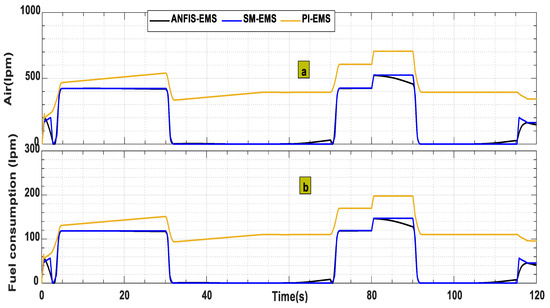
Figure 8.
Air and fuel consumption: (a) air consumption; (b) fuel consumption.
Hydrogen and fuel have identical forms, and they generate the same FC power. Table 2 highlights the crucial points of comparison between the methods described in the paper, such as response time, efficiency, fuel consumption, and the percentage of fuel preserved by each technique.

Table 2.
Comparison of the statistical findings of the performance criteria of proposed topologies.
The response times in the classical energy management strategies (PI and SM) were about 0.004 (s) and 0.02 (s), respectively, and ANFIS-EMS was 0.001 (s).
ANFIS improved the efficiency (98.3%), whereas the efficiency of classical EMSs was 96.05% for PI-EMS and 98% for SM-EMS. The ANFIS-EMS reduces the hydrogen consumption to (8%) compared with SM-EMS.
6. Conclusions
This work has shown the ANFIS controller’s impact on the HEV’s renewable energy management. The HEV was studied under Matlab Simulink, where we specified the same initial conditions for all systems.
The main objective of this study was to integrate artificial intelligence into the renewable energy management of two-wheel-drive motors.
The ANFIS-based power management technology outperformed the classic technologies at all points of comparison, having a very fast response time of 1 millisecond (less than a tenth of that of the classic technologies).
The proposed technique also excelled in system efficiency, reaching 98.25%, resulting in reduced energy exchange energy losses.
Fuel consumption is one of the main points in the comparison, as the proposed technology reduced the fuel consumption ratio to 8%.
To conclude, it may be deduced that use of the ANFIS controller in renewable power management improves EV autonomy by reducing hydrogen consumption and saving sources such as the battery and supercapacitors.
The proposed technique’s limits are that it is difficult to apply and it needs an expert.
The proposed study’s difficulties push the authors to consider other intelligent techniques and investigate them experimentally as future perspectives.
Author Contributions
Conceptualization, B.A.; Methodology, B.A.; Software, B.A. and H.M.A.; Validation, B.A. and H.M.A.; Formal analysis B.A.; Investigation, B.A. and H.M.A.; Resources, B.A.; Data curation, B.A.; Writing—original draft, B.A., H.M.A.; Writing—review and editing, B.A. and H.M.A.; Visualization, B.A.; Supervision, T.H. and G.Y. All authors have read and agreed to the published version of the manuscript.
Funding
This research received no external funding.
Institutional Review Board Statement
Not applicable.
Informed Consent Statement
Not applicable.
Data Availability Statement
Not applicable.
Conflicts of Interest
The authors declare no conflict of interest.
References
- Benhammou, A.; Tedjini, H.; Guettaf, Y.; Soumeur, M.A.; Hartani, M.A.; Hafsi, O.; Benabdelkader, A. Exploitation of Vehicle’s Kinetic Energy in Power Management of Tow -Wheel Drive Electric Vehicles Based on ANFIS DTC-SVM Comparative Study. Int. J. Hydrogen Energy 2021, 46, 27758–27769. [Google Scholar] [CrossRef]
- Habib, A.K.M.R.R.; Butler, K. Environmental and Economic Comparison of Hydrogen Fuel Cell and Battery Electric Vehicles. Future Technol. 2022, 1, 25–33. [Google Scholar] [CrossRef]
- Benhammou, A.; Hartani, M.A.; Tedjini, H.; Rezk, H.; Al-Dhaifallah, M. Improvement of Autonomy, Efficiency, and Stress of Fuel Cell Hybrid Electric Vehicle System Using Robust Controller. Sustainability 2023, 15, 5657. [Google Scholar] [CrossRef]
- Carello, M.; de Carvalho Pinheiro, H.; Longega, L.; Di Napoli, L. Design and Modelling of the Powertrain of a Hybrid Fuel Cell Electric Vehicle. SAE Int. J. Adv. Curr. Pract. Mobil 2021, 3, 2878–2892. [Google Scholar]
- Lee, U.; Jeon, S.; Lee, I. Design for Shared Autonomous Vehicle (SAV) System Employing Electrified Vehicles: Comparison of Battery Electric Vehicles (BEVs) and Fuel Cell Electric Vehicles (FCEVs). Clean. Eng. Technol. 2022, 8, 100505. [Google Scholar] [CrossRef]
- Sharma, A.; Sharma, S. Review of Power Electronics in Vehicle-to-Grid Systems. J. Energy Storage 2019, 21, 337–361. [Google Scholar] [CrossRef]
- Fachrizal, R.; Shepero, M.; van der Meer, D.; Munkhammar, J.; Widén, J. Smart Charging of Electric Vehicles Considering Photovoltaic Power Production and Electricity Consumption: A Review. ETransportation 2020, 4, 100056. [Google Scholar] [CrossRef]
- Amine, H.M.; Othmane, A.; Saad, M. The Impacts of Control Systems on Hybrid Energy Storage Systems in Remote DC-Microgrid System: A Comparative Study between PI and Super Twisting Sliding Mode Controllers. J. Energy Storage 2022, 47, 103586. [Google Scholar] [CrossRef]
- Zhang, X.; Li, Z.; Luo, L.; Fan, Y.; Du, Z. A Review on Thermal Management of Lithium-Ion Batteries for Electric Vehicles. Energy 2022, 238, 121652. [Google Scholar] [CrossRef]
- Song, K.; Ding, Y.; Hu, X.; Xu, H.; Wang, Y.; Cao, J. Degradation Adaptive Energy Management Strategy Using Fuel Cell State-of-Health for Fuel Economy Improvement of Hybrid Electric Vehicle. Appl. Energy 2021, 285, 116413. [Google Scholar] [CrossRef]
- Gupta, S.; Garg, R.; Singh, A. ANFIS-Based Control of Multi-Objective Grid Connected Inverter and Energy Management. J. Inst. Eng. India Ser. B 2020, 101, 1–14. [Google Scholar] [CrossRef]
- Habib, A.K.M.R.R.; Butler, K. Alternatives to Lithium-Ion Batteries in Electric Vehicles. Future Technol. 2022, 1, 33–34. [Google Scholar] [CrossRef]
- Soumeur, M.A.; Gasbaoui, B.; Abdelkhalek, O.; Ghouili, J.; Toumi, T.; Chakar, A. Comparative Study of Energy Management Strategies for Hybrid Proton Exchange Membrane Fuel Cell Four Wheel Drive Electric Vehicle. J. Power Sources 2020, 462, 228167. [Google Scholar] [CrossRef]
- Zhao, G.; Wang, X.; Negnevitsky, M.; Zhang, H. A Review of Air-Cooling Battery Thermal Management Systems for Electric and Hybrid Electric Vehicles. J. Power Sources 2021, 501, 230001. [Google Scholar] [CrossRef]
- Mounica, V.; Obulesu, Y. Hybrid Power Management Strategy with Fuel Cell, Battery, and Supercapacitor for Fuel Economy in Hybrid Electric Vehicle Application. Energies 2022, 15, 4185. [Google Scholar] [CrossRef]
- Gößling, S.; Nickig, N.; Bahr, M. 2-D+ 1-D PEM Fuel Cell Model for Fuel Cell System Simulations. Int. J. Hydrogen Energy 2021, 46, 34874–34882. [Google Scholar] [CrossRef]
- Brisset, S.; Radulescu, M. Design of a Brushless DC Permanent-Magnet Generator for Use in Micro-Wind Turbine Applications. Int. J. Appl. Electromagn. Mech. 2018, 56, 3–15. [Google Scholar]
- Laczko, A.A.; Brisset, S.; Radulescu, M. Modeling Approaches to Brushless DC Permanent-Magnet Generator for Use in Micro-Wind Turbine Applications. In Proceedings of the 2016 XXII International Conference on Electrical Machines (ICEM), Lausanne, Switzerland, 4 September 2016; pp. 445–451. [Google Scholar]
- Wu, Y.-C.; Feng, J.-W. Development and Application of Artificial Neural Network. Wirel. Pers. Commun. 2018, 102, 1645–1656. [Google Scholar] [CrossRef]
- Elsisi, M.; Tran, M.-Q.; Mahmoud, K.; Lehtonen, M.; Darwish, M.M. Robust Design of ANFIS-Based Blade Pitch Controller for Wind Energy Conversion Systems against Wind Speed Fluctuations. IEEE Access 2021, 9, 37894–37904. [Google Scholar] [CrossRef]
- Karaboga, D.; Kaya, E. Adaptive Network Based Fuzzy Inference System (ANFIS) Training Approaches: A Comprehensive Survey. Artif. Intell. Rev. 2019, 52, 2263–2293. [Google Scholar] [CrossRef]
Disclaimer/Publisher’s Note: The statements, opinions and data contained in all publications are solely those of the individual author(s) and contributor(s) and not of MDPI and/or the editor(s). MDPI and/or the editor(s) disclaim responsibility for any injury to people or property resulting from any ideas, methods, instructions or products referred to in the content. |
© 2023 by the authors. Licensee MDPI, Basel, Switzerland. This article is an open access article distributed under the terms and conditions of the Creative Commons Attribution (CC BY) license (https://creativecommons.org/licenses/by/4.0/).